If I told you that I speak Mexican Spanish and European Spanish, would you say I speak two languages or two dialects? Two varieties? Or just two different accents?
If you’ve found yourself confused, don’t worry. Borders between dialect vs language or dialect vs accent terms can be blurry. I remember my own confusion while studying Spanish philology.
For example, Portuguese and Spanish are classified as separate languages, even though they’re mutually intelligible (especially in the written form). Meanwhile, Mandarin and Cantonese are considered two dialects of the Chinese language although Mandarin speakers aren’t able to understand Cantonese speakers.
Why is this?
The answer is history and politics.
In general terms, separate countries classify their official language as a distinct language, while the varieties within the country are viewed as dialects. This vague inconsistency is precisely why linguists avoid these labels, instead preferring the term “varieties.”
Keep reading to understand the differences among languages, dialects, and accents once and for all!
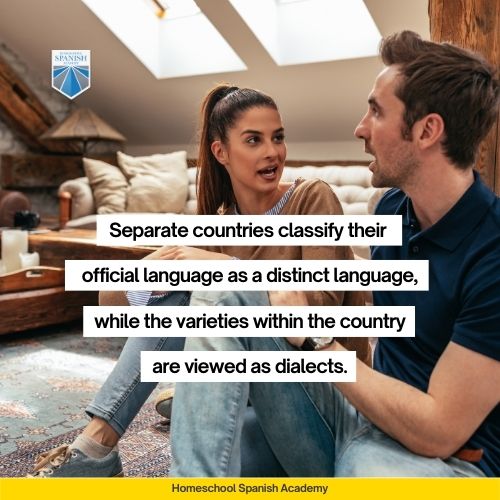
What’s a Language?
Let’s start unwinding the dialect vs language dilemma by tackling the term “language.”
Russian Jewish linguist, Max Weinreich, popularized the phrase “A language is a dialect with an army and navy.” This might sound funny but explains the arbitrariness of the difference between a language and a dialect. This phrase emphasizes the importance of political and social conditions that make people consider, for example, Spanish as a language and Taiwanese as a dialect of Chinese.
A language is a system of communication used within a country or a community—if this community has sufficient political and cultural power. Catalan is a language in the country of Spain, whereas many people still perceive the Hokkien dialect and Wu Chinese, for example, as dialects. Catalunya is a powerful state within Spain, and Chinese provinces are much more dependent on the central government of China.
For the above reasons, you can start learning Spanish, Portuguese, Arabic, or Chinese and later discover the dialects within them.

So, are Mexican Spanish and European Spanish two separate languages?
No, they’re not.
They are dialects or varieties of the Spanish standard language that is the official language of Spain and Mexico.
But do you know how many languages are spoken in Spain? Seven in total, and here they are, organized from the highest population to lowest:
- Spanish (99%)
- Catalan (8%)
- Valencian (4%)
- Galician (3%)
- Basque (1%)
- Extremaduran (0.4%)
- Aranese (0.007%)
What are Dialects?
A dialect, also called a variety, signals where a person comes from. It differs from other dialects within the same language in grammar and vocabulary. Some linguists also add phonological features, such as the pronunciation of vowels and consonants, and the intonation, but these are usually considered aspects of an accent.
So European Spanish and Mexican Spanish are examples of dialects, like British English and American English. They have differences in grammar and vocabulary but still, have a common core. If you learn standard English or standard Spanish, you’ll be able to communicate with speakers of both varieties.
What’s not a dialect? Well, let’s say you travel to Mexico City—you’ll hear people speaking with different accents depending on their social class. The fact is, a different accent is not equal to a different dialect.
What’s an Accent?
The accent refers to variations in pronunciation within the same language or even within the same dialect or variety. Accents differ from standard language.
It means that a speaker of the Rioplatense variety of Spanish in Argentina can speak the European variety of Spanish if needed, using its specific vocabulary and grammar, but still keep the regional accent of their homeland.
An English speaker can choose to learn any variety or dialect of Spanish and still pronounce it with a foreign accent.
The key thing to remember is that “accent” only refers to pronunciation, while dialect must include distinct grammar and vocabulary beyond regional pronunciations.

Exploring the Spanish Language: Dialects and Accents
Are you curious to know which Spanish dialect to learn? Let me tell you about dialects and accents within the Spanish language.
Spanish is one of the languages with the greatest number of speakers, so no wonder it has produced many varieties over the centuries. The main division between the varieties of Spanish is set between the Spanish peninsula and Latin America, but there are other places where people speak Spanish as their official language.
Some linguists talk about 8 types of Spanish dialects, but many more exist. These are the variety groups of Spanish:
1. Spanish on the Spanish Peninsula
- Northern Peninsular (Asturias, Castilla y León, Cantabria, Basque Country, Navarre, Aragón, Rioja, Provinces of Guadalajara and Cuenca)
- Central-Southern Peninsular (Madrid, Toledo, La Mancha)
- Southern Peninsular (Andalusia, Extremadura, and Murcia)
- Canarian (Canary Islands)
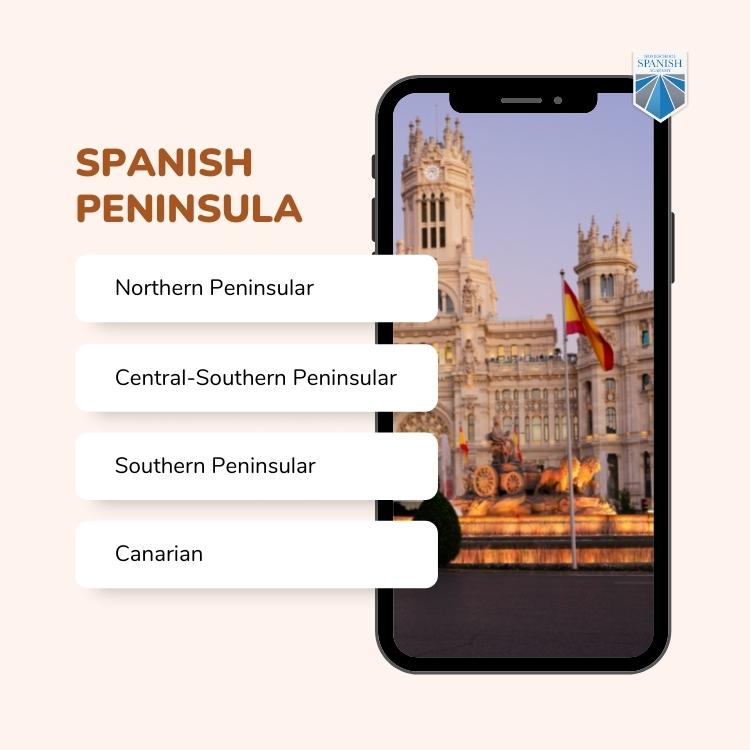
2. Spanish of the Americas
- New Mexican spoken in the USA
- Mexican
- Central American
- Caribbean (Cuba, Venezuela, Puerto Rico, Dominican Republic, Panama, Caribbean Colombia, and Caribbean Mexico and Gulf Coast Mexico)
- Andean-Pacific (Colombia, Peru, Ecuador, West Bolivian, and Andean Venezuela).
- Rioplatense (Argentina, Uruguay, East Bolivian, and Paraguay)
- Chilean (Chile, Cuyo)
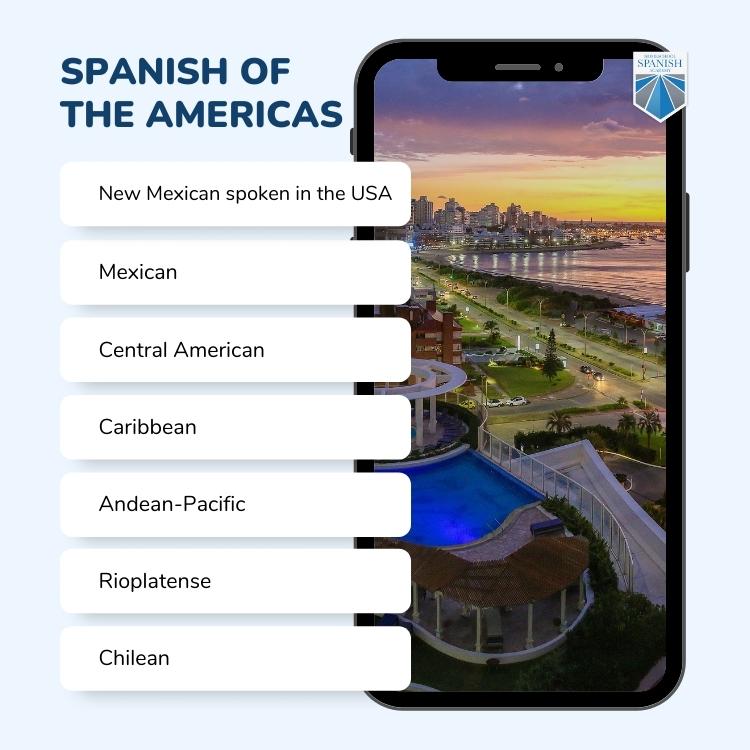
3. Other Dialects of Spanish
- Equatorial Guinea Spanish and Western Sahara Spanish in Africa
- Philippine Spanish in Asia
- Llanito, Spanish mixed with English spoken in Gibraltar
- Judaeo Spanish started by Jews who migrated from Spain in the 15th century and now spoken in Israel and Turkey
To learn about specific differences in grammar vocabulary and pronunciation, check out:
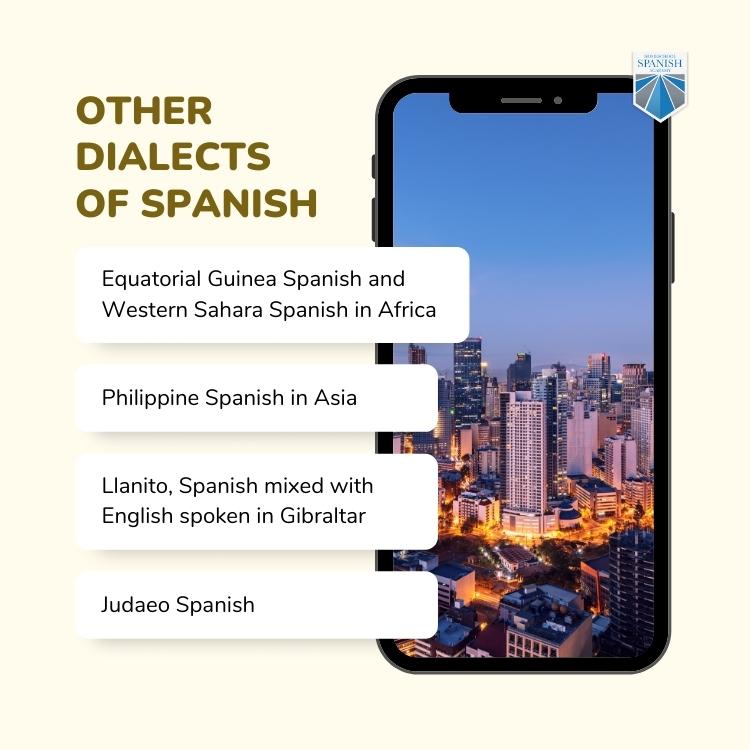
What About Accents?
Each of the above varieties has regional accents.
My Mexican husband speaks with an accent from Mexico City, but not a strong one as he lived in different places throughout his life. My older daughter speaks with an accent from the Yucatan península, where she picked up her kindergarten teacher’s pronunciation and it’s stuck ever since. I speak the Mexican dialect but with a foreign accent as it’s not my native language.
We all speak the same dialect but you can hear the differences in intonation and pronunciation. Interestingly, I used to speak European Spanish before I met my husband, and my university teachers had different accents within this dialect: Andalusian, Canarian, and the one from Madrid.
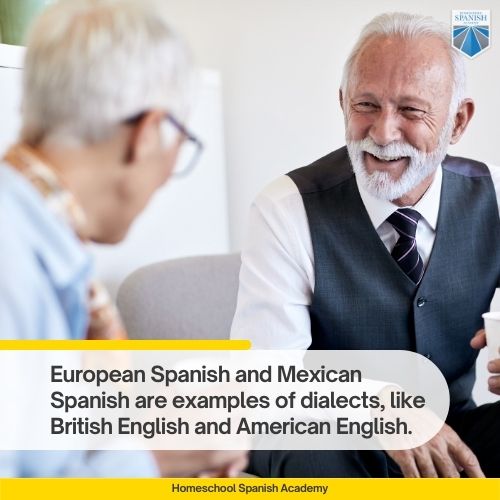
Do You Want to Learn Spanish?
Learning Spanish gives you countless benefits and opens many doors!
Reasons to Learn Spanish
If you know Spanish, you can travel easily to 20 countries where Spanish is an official language. If you know Spanish you can watch Casa de Papel (Money Heist) in the original version and read books by incredible Latin American Authors.
And did you know that in 2060 the US will be the 2nd largest Spanish-speaking country in the world, according to a study by Instituto Cervantes? Already, the U.S. is home to 41 million native Spanish speakers. Judging just by these numbers, knowing Spanish will get you more friends and better job opportunities.

Easiest Dialects to Start With
What’s the easiest dialect to start with? If you live in the U.S., I suggest opting for one of the Latin American dialects. Out of these, Mexico, Perú, Colombia, and Guatemala have the clearest pronunciation.
How to Start Learning Spanish
First, find your motivation and make a commitment. Then, sit down and think about how to fit Spanish into your busy schedule. Choose your resources and get started. Signing up for a free trial lesson is also an ideal way to set off in the right direction.
See also: Your Ultimate Guide to Basic Spanish for Beginners
Start Learning Spanish Now
Now you know the difference between dialect vs language, and how they’re both different from an accent. You’ve discovered which Spanish dialects you’ll encounter on your travels—and which are the easiest to learn.
Plus, by learning Spanish, or any other language, you’re improving your cognition and decision-making abilities! As you can see, it’s a brilliant idea to start learning Spanish right now!
Let Homeschool Spanish Academy help you reach your language goals. Sign up for a free trial class and make your first steps in the chosen dialect! Check out our affordable pricing and flexible programs!

Join one of the 40,000 classes that we teach each month and you can experience results like these

“It’s great being able to interact with native speaking people and having a conversation with them not just doing all the work on paper. It’s also an amazing opportunity to speak with native Spanish-speaking people without having to travel to a native Spanish-speaking country.”
– Melanie

“Getting to know wonderful teachers who care about me and my growth in language and education. Evelyn Gomez and Erick Cacao are two of the most extraordinary people I have ever met, and talking with them in Spanish at the beginning of classes is always so fulfilling and greatly contributes to my happiness, joy, and wellbeing.”
– Abby

“I love that my children have the opportunity to speak with a live person. They get to practice Spanish in a 1-1 setting while improve their speaking, writing and reading skills during their lessons. HSA is a great way to learn Spanish for all ages! My children are 6, 9 and 11. My oldest two (9 and 11) have been taking classes with HSA for almost 2 years now. They love seeing their teacher each week. They understand the importance of learning several languages. I’ve seen them grow and learn with HSA. I’m excited to see how they will improve the more classes they take. I highly recommend them. You can’t bet learning and speaking with a live teacher. I’ve tried other programs. It’s just not as motivating.”
– Karie Ann, Parent of 3
Ready to learn more Spanish grammar? Check these out!
- Dialect vs Accent: Is It a Language, Dialect, or Accent?
- How to Use the Past Participle as an Adjective in Spanish
- Punctuation Marks, Special Characters, and Other Symbols in Spanish
- What is the Conditional Tense in Spanish?
- Master All the Forms of Ser in Spanish: Your Ultimate Grammar Guide
- 20 Most Common Subjunctive Triggers in Spanish
- 23 Common Spanish Prepositions You Can Use Today
- 25 Common Subjunctive Phrases in Spanish Conversation
The post Dialect vs Accent: Is It a Language, Dialect, or Accent? appeared first on Homeschool Spanish Academy.
Read More [[{“value”:”If I told you that I speak Mexican Spanish and European Spanish, would you say I speak two languages or two dialects? Two varieties? Or just two different accents? If you’ve found yourself confused, don’t worry. Borders between dialect vs language or dialect vs accent terms can be blurry. I remember my own confusion while
The post Dialect vs Accent: Is It a Language, Dialect, or Accent? appeared first on Homeschool Spanish Academy.”}]]
 Spanish Grammar, dialect vs. accent, language vs. dialect, spanish grammar Homeschool Spanish Academy
Spanish Grammar, dialect vs. accent, language vs. dialect, spanish grammar Homeschool Spanish Academy
